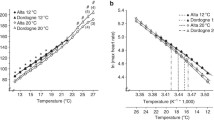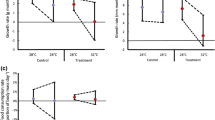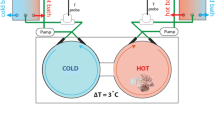Abstract
Fall chinook salmon evolved to emigrate during the summer months. The shift in the temperature preference we observed in smolting fall chinook but not spring chinook salmon may reflect a phylogenetic adaptation to summer emigration by (1) providing directional orientation as fall chinook salmon move into the marine environment, (2) maintaining optimal gill function during emigration and seawater entry, and/or (3) resetting thermoregulatory set-points to support physiological homeostasis once smolted fish enter the marine environment. Phylogenetically determined temperature adaptations and responses to thermal stress may not protect fall chinook salmon from the recent higher summer water temperatures, altered annual thermal regimes, and degraded cold water refugia that result from hydropower regulation of the Columbia and Snake rivers. The long-term survival of fall chinook salmon will likely require restoration of normal annual thermographs and rigorous changes in land use practices to protect critical thermal refugia and control maximum summer water temperatures in reservoirs.
Similar content being viewed by others
References
Baxter, C.V. & F.R. Hauer. 2000. Geomorphology, hyporheic exchange, and selection of spawning habitat by bull trout (Salvelinus confluentus). Can. J. Fish. Aquat. Sci. 57: 1470–1481.
Berman, C.H. & T.P. Quinn. 1991. Behavioral thermoregulation and homing by spring chinook salmon, Oncorhynchus tshawytscha (Walbaum), in the Yakima River. J. Fish Biol. 39: 301–312.
Brett, J.R. 1995. Energetics. pp. 3–68. In: C. Groot, L. Margolis & W.C. Clarke (ed.) Physiological Ecology of Pacific Salmon, UBC Press, Vancouver.
Cherry, D.S., K.L. Dickson & J. Cairns. 1975. Temperatures selected and avoided by fish at various acclimation temperatures. J. Fish. Res. Board Can. 32: 485–491.
Clarke, W.C., J.E. Shelbourn & J.R. Brett. 1981. Effect of arti-ficial photoperiod cycles, temperature, and salinity on growth and smolting in underyearling coho (Oncorhynchus kisutch), chinook (O. tshawytscha), and sockeye (O. nerka) salmon. Aquaculture 22: 105–116.
Clarke, W.C. & J.E. Shelbourn. 1985. Growth and development of seawater adaptability by juvenile fall chinook salmon (Oncorhynchus tshawytscha) in relation to temperature. Aquaculture 45: 21–31.
Clarke, W.C., R.E. Withler & J.E. Shelbourn. 1992. Genetic control of juvenile life history pattern in chinook salmon (Oncorhynchus tshawytscha). Can. J. Fish. Aquat. Sci.49: 2300–2306.
Clarke, W.C. & T. Hirano. 1995. Osmoregulation. pp. 317–377. In: C. Groot, L. Margolis & W.C. Clarke (ed.) Physiological Ecology of Pacific Salmon, UBC Press, Vancouver.
Cowley, D.J., M.A. Sheridan, T.L. Hoffnagle, A.J. Fivizzani, B.A. Barton & C.D. Eilertson. 1994. Changes in lipid metabolism and plasma concentrations of thyroxine, cortisol, and somatostatin in land-locked chinook salmon, Oncorhynchus tshawytscha, during smoltification. Aquaculture 121: 147–155.
Dickhoff, W.W., C.V. Sullivan & C.V. Mahnken. 1985. Thyroid hormones and gill ATPase during smoltification of Atlantic salmon (Salmo salar). Aquaculture 51: 376.
Duston, J., R.L. Saunders & D.E. Knox. 1991. Effects of increases in freshwater temperature on loss of smolt characteristics in Atlantic Salmon (Salmo salar). Can. J. Fish. Aquat. Sci. 48: 164–169.
Ebel, J.W., C.E. Becker, J.W. Mullan & H.L. Raymond. 1989. The Columbia River - toward a holistic understanding. pp. 205–219. In: D.P. Dodge (ed.) Proceedings of the International Large River Symposium, Can. Spec. Publ. Fish. Aquat. Sci. 106.
Ebersole, J.L., W.J. Liss & C.A. Frissell. 2001. Relationship between stream temperature, thermal refugia and rainbow trout Oncorhynchus mykiss abundance in arid-land streams in the northwestern United States. Ecol. Freshwater Fish 10: 1–10.
Folmar, L.C. & W.W. Dickhoff. 1980. The parr- smolt transformation (smoltification) and seawater adaptation in salmonids. A review of selected literature. Aquaculture 21: 1–37.
Hoar, W.S. 1976. Smolt transformation: evolution, behavior, and physiology. J. Fish. Res. Board Can. 33: 1234–1252.
Javaid, M.Y. & J.M. Anderson. 1967. Thermal acclimation and temperature selection in Atlantic salmon, Salmo salar, and rainbowtrout, S. gairdneri. J. Fish. Res. Board Can. 24: 1507–1513.
Johnston, C.E. & J.G. Eales. 1967. Purines in the integument of the Atlantic salmon (Salmo salar) during parr- smolt transformation. J. Fish. Res. Board Can. 24: 955–964.
Kelsch, S.W. & W.H. Neill. 1990. Temperature preference versus acclimation in fishes: selection for changing metabolic optima. Trans. Amer. Fish. Soc. 119: 601–610.
Kreeger, K.Y. 1994. Differences in the onset of salinity tolerance between juvenile chinook salmon from two coastal Oregon River systems. Can. J. Fish. Aquat. Sci. 52: 623–630.
Langdon, J.S. & J.E. Thorpe. 1985. The ontogeny of smoltifi-cation: developmental patterns of gill Na+/K+- ATPase, SDH, and chloride cells in juvenile Atlantic salmon, Salmo salar L. Aquaculture 45: 83–95.
McCormick, S.D. & R.L. Saunders. 1987. Preparatory physiological adaptations for marine life of salmonids: osmoregulation, growth, and metabolism. Amer. Fish. Soc. Symp. 1: 211–229.
Macdonald, J.S., I.K. Birtwell & G.M. Kruzynski. 1987. Food and habitat utilization by juvenile salmonids in the Campbell River estuary. Can. J. Fish. Aquat. Sci. 44: 1233–1246.
McInerney, J.E. 1964. Salinity preference: an orientation mechanism in salmon migrations. J. Fish. Res. Board Can. 21: 995–1018.
Nickerson, D.M., D.E. Facey & G.D. Grossman. 1989. Estimating physiological thresholds with continuous two-phase regression. Phys. Zool. 62: 866–887.
Neilsen, J.L., T.E. Lisle & V. Ozaki. 1994. Thermally stratified pools and their use by steelhead in northern California streams. Trans. Amer. Fish. Soc. 123: 613–626.
Piper, R.G., I.B. McElwain, L.E. Orme, J.P. McCraren, L.G. Fowler & J.R.6Leonard. 1986. Transportation of live fishes. pp. 360–362. In: Fish Hatchery Management, Amer. Fish. Soc., Bethesda.
Poole, G.C. & C.H. Berman. 2001. An ecological perspective on in-stream temperature: natural heat dynamics and mechanisms of human-caused thermal degradation. Ecol. Man. (in press).
Quinn, T.P. & D.J. Adams. 1996. Environmental changes affecting the migratory timing of American shad and sockeye salmon. Ecology 77: 1151–1162.
Schrock, R.M., J.W. Beeman, D.W. Rondorf, & P.V. Haner. 1994. A microassay for gill sodium, potassium-activated ATPase in juvenile Pacific salmonids. Trans. Amer. Fish. Soc. 123: 223–229.
Torgersen, C.E., D.M. Price, H.W. Li & B.A. McIntosh. 1999. Multiscale thermal refugia and stream habitat associations of chinook salmon in northeastern Oregon. Ecological Applications 9: 301–319.
Ward, J.V. & J.A. Stanford. 1995. Ecological connectivity in alluvial river ecosystems and its disruption by flow regulation. Regulated Rivers: Research and Management 11: 105–119.
Welch, D.W., A.I. Chigirinsky & Y. Ishida. 1995. Upper thermal limits on the oceanic distribution of Pacific salmon (Oncorhynchus spp.) in the spring. Can. J. Fish. Aquat. Sci. 52: 489–503.
Yeager, D.P. & G.R. Ultsch. 1989. Physiological regulation and conformation: a BASIC program for the determination of critical points. Physiol. Zool. 62: 888–907.
Zaugg, W.S. 1981. Advanced photoperiod and water temperature effects on gill Na+- K+ adenosine triphosphatase activity and migration of juvenile steelhead (Salmo gairdneri). Can. J. Fish. Aquat. Sci. 38: 758–764.
Zaugg, W.S. 1982. Asimplified preparation for adenosine triphosphatase determination in gill tissue. Can. J. Fish. Aquat. Sci. 39: 215–217.
Author information
Authors and Affiliations
Rights and permissions
About this article
Cite this article
Sauter, S.T., Crawshaw, L.I. & Maule, A.G. Behavioral Thermoregulation by Juvenile Spring and Fall Chinook Salmon, Oncorhynchus Tshawytscha, during Smoltification. Environmental Biology of Fishes 61, 295–304 (2001). https://doi.org/10.1023/A:1010849019677
Issue Date:
DOI: https://doi.org/10.1023/A:1010849019677




